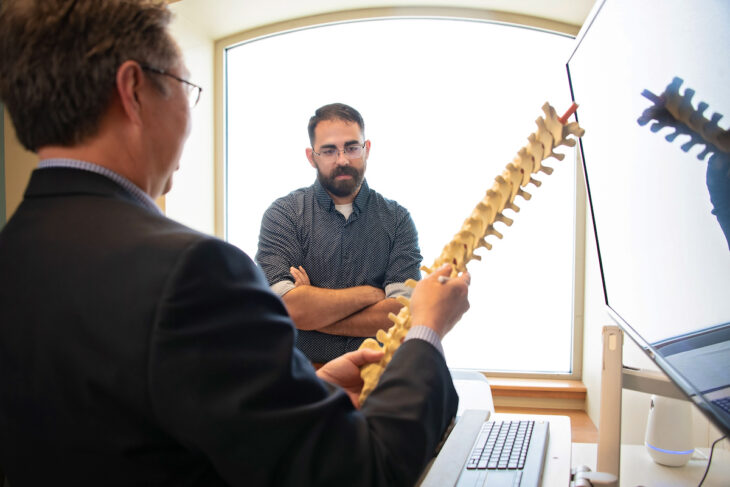
Who should I see for back pain?
From physical therapists and chiropractors to physiatrists and orthopedic surgeons, you have options. Learn about which doctors may be the best fit for you.
Just as back pain has a range of causes, there are a wide variety of back specialists who can help treat your pain. It can be challenging to determine who is best equipped to help you feel better and get back to living your life. This article walks through basic information about back pain and how different types of providers are able to help you.
The Highlights
- Unless you are experiencing red flag symptoms (see below), start with conservative care options before you explore surgical care
- The longer you’ve been experiencing pain, the more likely you’ll want to consult an orthopedic specialist
- If you don’t know where to start, visit your primary care doctor or a physiatrist (a pain management specialist)
What kind of pain are you experiencing?
Back pain falls into three main categories based on how long you have been experiencing pain:
Acute Pain
You’ve been experiencing pain for less than three months. Acute pain is often associated with a specific event or injury that directly caused your pain.
Subacute Pain
You’ve been experiencing pain for three to six months. The source of your pain can likely still be traced to a specific event but may have several contributing factors.
Chronic Pain
You’ve been experiencing pain for more than six months or even having symptoms for years. There can be multiple factors causing your pain.
Red Flag Symptoms
Most concerning symptoms are linked to the possibility of being neuropathically compromised, meaning that something is likely disrupting communication between your nerves and your brain.
• Significant change in balance
• Significant bowel or bladder change (ex: not being aware of soiling)
• Loss of sensation around saddle area (also known as saddle anesthesia)
• Profound weakness in your legs
• Rapid sensory change in all four limbs
If you experience any of the above symptoms, go to the emergency room. Then, we recommend seeking evaluation by a spine surgeon.
Types of Doctors for Back Pain:
Physical Therapists
Physical therapists are healthcare providers who help ease your pain and help you regain the movement you use in daily life. Physical therapy is a conservative approach used to help treat acute injuries and is often used in conjunction with other specialist’s care plans to help your body recover. If you visit a physical therapist, they may:
- Evaluate your condition based on your movement
- Use manual manipulation to help ease your pain
- Prescribe exercises to help you heal and regain range of motion
- Refer you to another specialist if necessary
Training & Education:
Becoming a physical therapist typically requires:
- A bachelor’s degree
- Doctor of Physical Therapy (DPT)
- Completing a clinical residency program (1 Year)
Chiropractors
Chiropractors are holistic providers who focus on realigning your spine through manual manipulations. While experts disagree about the role of chiropractic care in treatment, there has been evidence to show that chiropractic care is effective in treating low back pain. Like physical therapy, this is a conservative, non-invasive treatment method for easing acute back pain. If you have a complex injury or experiencing chronic back pain, you may consider seeking the recommendation of a medically trained physician such as a physiatrist or spine surgeon. A chiropractor may be able to help you by:
- Making manual adjustments with their hands to align your spine and relieve pain
- Discussing lifestyle changes that can help improve mobility and limit pain
- Recommend other holistic approaches such as orthotics
Training & Education:
- A bachelor’s degree
- Doctor of Chiropractic (DC)
- Clinical Internship
Physiatrists
Also known as pain management doctors, or interventional pain specialists, physiatrists are medical doctors (MD) or osteopathic doctors (DO) who specialize in physical medicine and rehabilitation. They treat patients who have pain in their bones, joints, and nervous systems. Because of their specialty, they are equipped to diagnose and treat pain from acute injuries, as well as chronic pain issues. They have a wide variety of treatments available and develop highly individualized care plans for their patients. Physiatrists frequently utilize non-surgical treatments such as injections or ultrasound procedures combined with prescribed physical therapy for long-term success. If necessary, they also refer patients to other spine specialists, such as spine surgeons. A physiatrist may be able to help you by:
- Diagnosing the source of your pain and developing an individualized treatment plan
- Using non-operative and non-invasive methods to help treat your pian (such as injections)
- Treat issues such as acute and chronic back pain, inflammation, arthritis, spinal stenosis, sciatica, SI joint dysfunction, and infection
- Recommend physical therapy to support your treatment
- Recognize if you need to see a spine surgeon and refer you if necessary
Training & Education:
- A bachelor’s degree
- Doctor of Medicine (MD) or Doctor of Osteopathic Medicine (DO)
- Residency Training (4 Years)
Orthopedic Spine Surgeons & Neurosurgeons
Orthopedic spine surgeons are medical doctors who have specifically trained to treat musculoskeletal conditions of the neck and back. Neurosurgeons often treat the same spine conditions as spine surgeons, but their training background focuses on treating conditions of the nervous system (brain, spinal cord, etc. Both professionals are highly trained, and which one is best for you depends on your specific condition.
Patients will typically see their primary care doctor or physiatrist first, before being referred to a spine surgeon. When treating back pain, they will recommend conservative treatment options first, and will discuss surgery. Orthopedic surgeons and neurosurgeons may be able to help you by:
- Diagnosing the cause of your pain and offer a variety of non-surgical and surgical treatment to help your pain
- Helping treat a variety of back issues such as stenosis, osteoporosis, scoliosis, arthritis, fractures and disc herniations
- Recommending physical therapy to support your treatment
Education & Training
Orthopedic spine surgeon:
- A bachelor’s degree
- Doctor of Medicine (MD)
- Residency Training (5 years)
- Spine Fellowship
Neurosurgeon:
- A bachelor’s degree
- Doctor of Medicine (MD) or Doctor of Osteopathic Medicine (DO)
- General Surgery Internship
- Residency Training (6-7 Years)
If you are experiencing back pain and are unsure of where to start your journey, we recommend visiting your primary care physician, or scheduling an appointment with a physiatrist to begin your care plan.
To find out more about how to understand your pain and navigate your treatment, download our back pain guide.

This guide includes:
- How to begin to understand and define your pain
- What to expect from treatment
- Learn about non-surgical treatment options
- When we recommend scheduling a consultation with a spine physician